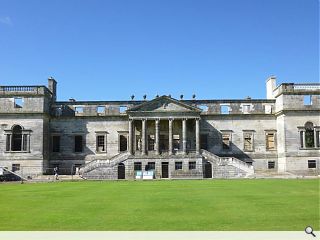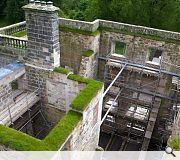Simpson & Brown complete Penicuik House restoration
August 29 2014
Penicuik House, one of the finest Palladian style buildings in Scotland, has been rescued from ruin following completion of extensive stabilisation works by conservation specialists Simpson & Brown.Abandoned in 1899 following a devastating fire the home had deteriorated to the point of threatened collapse, prompting the formation of the Penicuik House Preservation Trust who began measures to make the ruin safe and allow public access from 2007.
Since then hundreds of tons of debris have been removed, allowing internal walls to be rebuilt (including one which ‘rocked’ when pushed against) as necessary and steelwork bracing to provide additional structural stability. These new interventions make use of brick so as to be legible against historic elements.
Important architectural features such as pencheck staircases and an imposing entrance arch have also been preserved whilst bricked up windows have been opened and fitted with metal bars to prevent trespass. Sadly however much of the original flooring had already been removed, necessitating use of gravel to provide level access.
Works to the surrounding Penicuik Estate such as reinstatement of 18th century pathways and repairs to a Roman bridge and a new pair of historically accurate Chinese gates have been commissioned to stand within the grounds.
In their conservation report Simpson & Brown noted: “The completion of the portico and architectural embellishments on the wallheads dramatically enhanced the appearance of the house and for the first time in many years the architectural elevations are virtually complete, restoring an imposing centrepiece to the designed landscape. However, the architectural quality of the elevations lacked the important effect provided by fenestration. With this in mind and bolstered by the success that the work to the portico and wallheads had on the north elevation it was decided to refenestrate the building.
“New unglazed timber sash and case windows have been manufactured exactly matching the surviving windows and these have been fitted into the original window openings.”
|
|
2 Comments
#2 Posted by Stephen Newsom on 2 Sep 2014 at 13:27 PM
In answer to the above, yes CDM did apply and I was the CDM-c. There were considerable risks associated with carrying out the stabilisation of the ruins, all of which were dealt with by careful planning and involving the whole design team and the contractor in devising methods of working. Your question about the treatment wallheads is a pertinent one, but was carefully considered. Turf topping is a tried and tested solution for keeping rainwater out of vulnerable wall heads - no future mowing is anticipated. A maintenance regime is in place for monitoring the ruins as they will be open to the public under controlled arrangements.
Post your comments
Read next: Hillhead Community Centre opens its doors
Read previous: Strathclyde University complete revamped engineering hub
Back to August 2014
Like us on Facebook
Become a fan and share
News Archive
Search News
Features & Reports
For more information from the industry visit our Features & Reports section.






Would a stone cope not have been more likely to prevent water ingress into the wall heads?